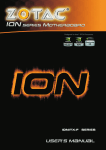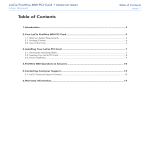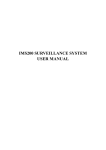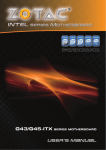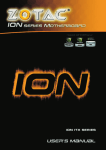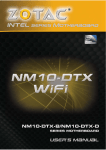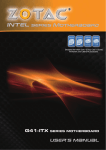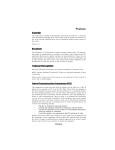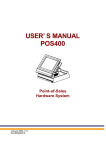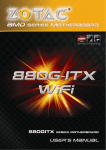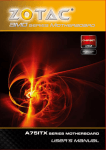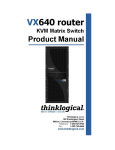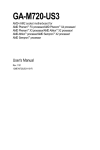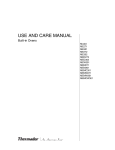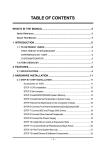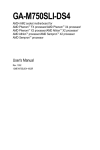Download 9 0
Transcript
WARNING! Electronic Emission Notices Federal Communications Commission (FCC) Statement This equipment has been tested and found to comply with the limits for a Class B digital device, pursuant to Part 15 of FCC Rules. These limits are designed to provide reasonable protection against harmful interference in a residential installation. This equipment generates, uses and can radiate radio frequency energy and, if not installed and used in accordance with instructions contained in this manual, may cause harmful interference to radio and television communications. However, there is no guarantee that interference will not occur in a particular installation. If this equipment does cause harmful interference to radio or television reception, which can be determined by turning the equipment off and on, the user is encouraged to try to correct the interference by one or more of the following measures: - - - - REORIENT OR RELOCATE THE RECEIVING ANTENNA INCREASE THE SEPARATION BETWEEN THE EQUIPMENT AND THE RECEIVER CONNECT THE EQUIPMENT INTO AN OUTLET ON A CIRCUIT DIFFERENT FROM THAT OF THE RECEIVER CONSULT THE DEALER OR AN EXPERIENCED AUDIO/TELEVISION TECHNICIAN NOTE: Connecting this device to peripheral devices that do not comply with Class B requirements, or using an unshielded peripheral data cable, could also result in harmful interference to radio or television reception. The user is cautioned that any changes or modifications not expressly approved by the party responsible for compliance could void the user’s authority to operate this equipment. To ensure that the use of this product does not contribute to interference, it is necessary to use shielded I/O cables. Copyright This manual is copyrighted with all rights reserved. No portion of this manual may be copied or reproduced by any means. While every precaution has been taken in the preparation of this manual, no responsibility for errors or omissions is assumed. Neither is any liability assumed for damages resulting from the use of the information contained herein. Trademarks All brand names, logos and registered trademarks mentioned are property of their respective owners. NForce 750a series Motherboard Table of Contents Motherboard Specifications-------------------------------------------------------------------- 4 Motherboard Layout------------------------------------------------------------------------------ 6 Hardware Installation----------------------------------------------------------------------------- 8 Safety Instructions------------------------------------------------------------------------------ 8 Preparing The Motherboard-------------------------------------------------------------------- 8 Installing the CPU------------------------------------------------------------------------------- 8 Installing the CPU Fan------------------------------------------------------------------------- 10 Installing Memory DIMMs--------------------------------------------------------------------- 10 Installing the Motherboard-------------------------------------------------------------------- 11 Installing the I/O Shield------------------------------------------------------------------------ 11 Connecting Cables And Setting Switches------------------------------------------------- 12 24-pin ATX Power (PW1)---------------------------------------------------------------------- 13 8-pin ATX 12V Power (PW2)----------------------------------------------------------------- 14 Speaker Connector-SPK---------------------------------------------------------------------- 15 AUX Power (optional)-------------------------------------------------------------------------- 14 Serial Port connector-COM------------------------------------------------------------------ 15 Case Open Detect Connector J1H4------------------------------------------------------- 15 IEEE1394 Connector - CN4(optional)----------------------------------------------------- 16 Connecting Serial ATA Cables--------------------------------------------------------------- 17 Connecting Internal Headers----------------------------------------------------------------- 18 Front Panel Header----------------------------------------------------------------------------- 18 USB Headers------------------------------------------------------------------------------------ 19 FP Audio Connector---------------------------------------------------------------------------- 20 Fan Connections-------------------------------------------------------------------------------- 21 Expansion Slots--------------------------------------------------------------------------------- 22 PCI Slots------------------------------------------------------------------------------------------ 22 PCI Express x16 Slots------------------------------------------------------------------------- 22 PCI Express x1 Slots--------------------------------------------------------------------------- 22 Jumper Settings--------------------------------------------------------------------------------- 23 Hoppy Disk Drive Connector-FDD---------------------------------------------------------- 24 Hard Disk Connector-IDE--------------------------------------------------------------------- 24 Configuring the BIOS----------------------------------------------------------------------------- 25 About the Setup Utility------------------------------------------------------------------------- 25 Table of Contents Main Menu-------------------------------------------------------------------------------------------- 26 Flash Update Procedure ------------------------------------------------------------------------ 30 Installing Drivers And Software--------------------------------------------------------------- 31 HDMI Setup ------------------------------------------------------------------------------------------ 32 Realtek HD Audio Driver Setup --------------------------------------------------------------- 34 Getting Started----------------------------------------------------------------------------------- 34 Sound Effect-------------------------------------------------------------------------------------- 34 Environment Simulation----------------------------------------------------------------------- 34 Equalizer Selection ---------------------------------------------------------------------------- 35 Frequently Used Equalizer Setting--------------------------------------------------------- 35 Karaoke Mode----------------------------------------------------------------------------------- 35 Mixer----------------------------------------------------------------------------------------------- 36 Playback control---------------------------------------------------------------------------- 36 Recording control--------------------------------------------------------------------------- 37 Audio I/O-------------------------------------------------------------------------------------- 38 Speaker Configuration-------------------------------------------------------------------- 39 Global Connector Settings--------------------------------------------------------------- 40 S/PDIF ---------------------------------------------------------------------------------------- 40 Speaker Calibration------------------------------------------------------------------------ 41 Microphone---------------------------------------------------------------------------------- 42 Noise Suppression------------------------------------------------------------------------- 42 Beam Forming------------------------------------------------------------------------------ 42 Acoustic Echo Cancellation-------------------------------------------------------------- 42 Audio Demo---------------------------------------------------------------------------------- 43 Information ---------------------------------------------------------------------------------- 43 Setup of SLI Configuration--------------------------------------------------------------------- 44 SATA RAID User Manual------------------------------------------------------------------------- 46 Setting up the BIOS---------------------------------------------------------------------------- 46 Entering the RAID BIOS Setup-------------------------------------------------------------- 48 Installing the RAID Drives--------------------------------------------------------------------- 51 NForce 750a series Motherboard Motherboard Specifications q Chipset NVIDIA MCP72 Series q Size ATX form factor of 12 inch x 8.6 inch qMicroprocessor support Phenom/Athlon/Sempron with socket AM2/AM2+ qOperating systems: Supports Windows XP 32bit/64bit and Windows Vista 32bit/64bit qSystem Memory support Supports DDRII533/667/800/1066. Supports up to 8GBs DDRII memorys with 4 slots and 4GBs with 2 slots. qUSB 2.0 Ports v Supports hot plug and play v Twelve USB 2.0 ports (four rear panel ports, eight from onboard USB headers) v Supports wake-up from S1 v Supports USB 2.0 protocol up to 480 Mbps transmission rate qOnboard Serial ATA II v Independent DMA operation on six ports (optional). v Data transfer rates of 300Mb/s. q Onboard LAN v LAN interface built-in onboard v Supports 10/100/1000Mbps Ethernet, 1000Mbps Ethernet is optional. qOnboard Audio(optional) v Azalia High-Definition audio v Supports 6-channel/8-channel audio v Supports Jack-Sensing function q PCI Express Support v Supports PCI Express 2.0 v Supports two PCIEx16 slot with 8-1an bandwidth and two PCIEx1 slot(optional) v Low power consumption and power management features v Supports 8+8 SLI technology qGreen Function Before You Begin v RTC timer to power-on the system v AC power failure recovery q Onboard IEEE1394(optional) v One 1394 port on back panel,one on pin header v Compliant with IEEE1394 OHCI specifications v1.0 and v1.1 v Integrated 400Mb 2-port PHY q Onboard display Support v Integrates 750a SLI engine core. v Support Hybrid SLI to increase graphics performance with GeForce® Boost and provide intelligent power management with HybridPowerTM v DVI/HDMI output support(optional) q Expansion Slots v Two PCI Express x1 slot(optional) v Two PCI Express x16 Graphics slot v Two PCI bus master slots - ver.2.3 compliant NForce 750a series Motherboard Motherboard Layout Figure 1 shows the motherboard and Figures 2 shows the back panel connectors. 24 16 17 18 19 20 21 22 23 SYS FAN - 1 IDE PW1 SATA1 SATA3 FP1 120 240 120 240 120 240 120 240 USB - 3 Chipset SATA4 SATA5 SATA6 USB - 4 SATA2 USB - 1 SPEAKER USB - 2 PCI J1H4 CCMOS COM PCI Express x1 PCI Express x1 121 DDRII - 1 121 DDRII - 2 121 DDRII - 3 121 DDRII - 4 PW2 AUX _ POWER 1394 PCI PCI Express x16 slot - 1 SYS FAN - 2 PCI Express x16 slot - 2 CHIP FAN CPU_FAN CPU Socket 2 3 4 5 6 7 FDD 8 USB/LAN PS2 Audio HDMI FP _ S1 USB / 1394 SPDIF OUT VGA / DVI 11 15 Figure 1. 14 13 10 12 9 Board Layout 1.Front Panel Connector 12. PCI Express x16 slots 23. SYS fan Connectors 2.USB Connectors 13. AUX power Connector (optional) 24. SATA connectors 3. Speaker Connector 14. 8-pin Power connector 4.IEEE1394 Connector(optional) 15. Backpanel connectors 5.Clear CMOS jumper 16. DDRII DIMM Sockets(optional) 6.J1H4-case open detection connector(optional) 17. 24-pin ATX power connector 7.COM connector(optional) 18. CPU Socket 8. Floppy Disk Drive Connector 19. IDE Connector 9. PCI Slots 20. CPU fan Connector 10. Front Panel audio Connector 21. Chip fan Connector 11. PCI Express x1 slot(optional) 22. Chipset Rear Panel Figure 2: Backpanel connectors With 8-Channel audio output 2 4 3 With 6-Channel audio output 8 9 10 5 6 6 1.PS/2 Mouse Port 4. HDMI Port(optional) 2.PS/2 Keyboard Port 5. VGA Port 3.SPDIF OUT 6. USB Port 7. Port Blue Green Pink Orange Black Grey 2-Channel Line-In Line-Out Mic In -- --- 4-Channel Line-In Front Speaker Out Mic In -Rear Speaker Out -- 7 11 6-Channel Line-In Front Speaker Out Mic In Center/Subwoofer Rear Speaker Out -- 8-Channel Line-In Front Speaker Out Mic In Center/Subwoofer Rear Speaker Out Side Speaker Out 8.DVI Out Port(optional) 9.IEEE1394 Port(optional) 10.Lan Port with LEDs to indicate status. ·Yellow/Light Up/Blink = 10 Mbps/Link/Activity ·Yellow and Green/Light Up/Blink = 100 Mbps/Link/Activity ·Orange and Red /Light UP/Blink = 1000 Mbps/Link/Activity 11.Port Blue Green Pink 2-Channel Line-In Line-Out Mic In 4-Channel Rear Speaker Out Front Speaker Out Mic In 6-Channe Rear Speaker Out Front Speaker Out Center/Subwoofer NForce 750a series Motherboard Hardware Installation This section will guide you through the installation of the motherboard. The topics covered in this section are: qPreparing the motherboard v Installing the CPU v Installing the CPU fan v Installing the memory q Installing the motherboard qConnecting cables and setting switches Safety Instructions To reduce the risk of fire, electric shock, and injury, always follow basic safety precations. Remember to remove power from your computer by disconnecting the AC main source before removing or installing any equipment from/to the computer chassis. Preparing the Motherboard The motherboard shipped in the box does not contain a CPU and memory. You need to purchase these to complete this installation. Installing the CPU Be very careful when handling the CPU. Make sure not to bend or break any pins on the back. Hold the processor only by the edges and do not touch the bottom of the processor. Use the following procedure to install the CPU onto the motherboard. Hardware Installation 1. Please turn off the power and unplug the power cord before installing the CPU. Pull the lever up and away from the socket until it is at a 90 degree angle to the motherboard. 2. Look for the gold arrow on the CPU. The gold arrow should point away from the lever pivot. The CPU can only sit properly in the socket in the correct orientation. 3. If the CPU is correctly seated, the pins should be completely embedded in the socket and can not be seen (Please note that any deviation from the correct installation procedures may cause permanent damage to your motherboard). 4. Press the CPU down firmly into the socket and close the lever. As the CPU is likely to move while the lever is being closed, always close the lever with your fingers pressing tightly on top of the CPU to make sure the CPU is properly and completely seated in the socket. 5. When you are installing the CPU, make sure the CPU has a heat sink and a cooling fan attached on the top to prevent overheating. If you do not have the heat sink and cooling fan, contact your dealer to purchase and install them before turning on the computer. NForce 750a series Motherboard Installing the CPU Fan There are many different fan types that can be used with this motherboard. Follow the instruction that came with your fan assembly. Be sure that the fan orientation is correct for your chassis type and your fan assembly. Installing Memory DIMMs Your new motherboard has four 1.8V 240-pin slots for DDR2 memory DDRII 1 and DDRII 2 are optional. These slots support 256 Mb, 512 Mb, 1Gb and 2Gb DDR2. There must be at least one memory bank populated to ensure normal operation. Use the following the recommendations for installing memory. (See Figure 1 on page 6 for the location of the memory slots.) qOne DIMM: You can install the DIMM into any slot. qTwo DIMMs: Install into slots 1 and 2,or 3 and 4. The idea is to run on dual channel mode. qFour DIMMs: Install into slots 1,2,3 and 4. The idea is to run on dual channel mode. DDRII-1 DDRII-2 DDRII-3 DDRII-4 Use the following procedure to install memory DIMMs into the slots on the motherboard. Note that there is only one gap near the center of the DIMM slot. This slot matches the slot on the memory DIMM to ensure the component is installed properly. 1.Unlock a DIMM slot by pressing the module clips outward. 10 Hardware Installation 2.Align the memory module to the DIMM slot, and insert the module vertically into the DIMM slot. The plastic clips at both sides of the DIMM slot automatically lock the DIMM into the connector. Installing the Motherboard The sequence of installing the motherboard into the chassis depends on the chassis you are using and if you are replacing an existing motherboard or working with an empty chassis. Determine if it would be easier to make all the connections prior to this step or to secure the motherboard and then make all the connections. It is normally easier to secure the motherboard first. Use the following procedure to install the I/O shield and secure the motherboard into the chassis. Note: Be sure that the CPU fan assembly has enough clearance for the chassis covers to lock into place and for the expansion cards. Also make sure the CPU Fan assembly is aligned with the vents on the covers. Installing the I/O Shield The motherboard kit comes with an I/O shield that is used to block radio frequency transmissions, protects internal components from dust and foreign objects, and promotes correct airflow within the chassis. Before installing the motherboard, install the I/O shield from the inside of the chassis. Press the I/O shield into place and make sure it fits securely. If the I/O shield does not fit into the chassis, you would need to obtain the proper size from the chassis supplier. 11 NForce 750a series Motherboard Connecting Cables and Setting Switches This section takes you through all the connections and switch settings necessary on the motherboard. See Figure 1 to locate the connectors and jumpers referenced in the following procedure. 12 Hardware Installation 24-pin ATX Power (PW1) PW1 is the main power supply connector located along the edge of the board next to the DIMM slots. Make sure that the power supply cable and pins are properly aligned with the connector on the motherboard. Firmly plug the power supply cable into the connector and make sure it is secure. Table 1. P W1 Pin Assignments Connector Pin Signal Pin Signal 1 +3.3V 13 +3.3V 2 +3.3V 14 -12V 3 GND 15 GND 4 +5V 16 PS_ON 5 GND 17 GND 6 +5V 18 GND 7 GND 19 GND 8 PWROK 20 -5V 9 +5V_AUX 21 +5V 10 +12V 22 +5V 11 +12V 23 +5V 12 +3.3V 24 GND 24 13 12 1 13 NForce 750a series Motherboard 8-pin ATX 12V Power (PW2) 1 PW2, the 8-pin ATX 12V power connection, is used to provide power to the CPU. Align the pins to the connector and press firmly until seated. PW2 - Pin Definition 4 PIN Assignment 1 GND 2 GND 3 GND 4 GND 5 +12V 6 +12V 7 +12V 8 +12V AUX Power(Optional) 1 AUX Power - Pin Definition PIN 1 2 3 4 14 Assignment +12V GND GND +5V Speaker Connector - SPK SPK - Pin Definition PIN 1 2 3 4 Assignment VCC NC NC SPK- SPK 1 Serial Port Connector - COM COM - Pin Definition PIN Assignment 1 DCD 2 RXD 3 TXD 4 DTR 5 GND 6 DSR 7 RTS 8 CTS 9 RI 10 NC COM 9 10 1 2 Case Open Detect Connector - J1H4 J1H4 1 15 NForce 750a series Motherboard Hardware Installation IEEE 1394 Connector: CN4 (optional) The motherboard provides one 1394 pin headers that allow you to connect IEEE 1394 ports. Certainly, you can connect to real panel directly. 9 10 1 2 CN4- Pin Definition PIN Assignment 1 TPA+ 2 TPA3 Ground 4 Ground 5 TPB+ 6 TPB7 Cable power 8 Cable power 9 Key (no pin) 10 Ground IEEE 1394 Cable (optional) 16 Connecting Serial ATA Cables(SATA-1~SATA-6 Optional) The Serial ATA II connector is used to connect the Serial ATA II device to the motherboard. These connectors support the thin Serial ATA II cables for primary storage devices. The current Serial ATA II interface allows up to 3Gb/s data transfer rate. There are six serial ATA connectors on the motherboard that support AHCI and RAID configurations .(SATA5,&SATA6 does not support IDE mode.) 1 SATA-4 1 SATA-5 1 SATA-6 SATA-1 1 SATA-2 1 1 SATA-2 SATA-1/SATA-2/SATA3/SATA4/SATA5/SATA6 - Pin Definition PIN SIGNAL 1 2 3 4 5 6 7 GND TXP TXN GND RXN RXP GND 17 Hardware Installation NForce 750a series Motherboard Connecting Internal Headers Front Panel Header The front panel header on this motherboard is one connector used to connect the following four cables (see Table 2 for pin definitions): q PWRLED Attach the front panel power LED cable to these two pins of the connector. The Power LED indicates the system’s status. Front Panel Header Pins 10 KEY GND 8 6 PWR_SW 4 PW_LED2 PW_LED+ FP1 9 7 5 3 1 NC RESET GND HDD_LEDHDD_LED+ Note: Some chassis do not have all four cables. Be sure to match the name on the connectors to the corresponding pins. q PWR SW Attach the power button cable from the case to these two pins. Pressing the power button on the front panel turns the system on and off rather than using the power supply button. q HDD LED Attach the hard disk drive indicator LED cable to these two pins. The HDD indicator LED indicates the activity status of the hard disks. qRST SW Attach the Reset switch cable from the front panel of the case to these two pins. The system restarts when the RESET switch is pressed. 18 USB Headers This motherboard contains four USB 2.0 ports that are exposed on the rear panel of the chassis(Figure 2). The motherboard also contains four 10-pin internal header connectors onboard. 1.Secure the bracket to either the front or rear panel of your chassis (not all chassis are equipped with the front panel option). 9 1 10 2 F_USB1/F_USB2/F_USB3/F_USB4 -Pin Definition PIN Assignment 1 2 3 4 5 6 7 8 9 10 VCC VCC USBP0- USBP1USBP0+ USBP1+ GND GND KEY OC# USB2 USB1 USB4 USB3 19 NForce 750a series Motherboard Hardware Installation FP Audio Connector The audio connector supports HD audio standard and provides two kinds of audio output choices: the Front Audio, the Rear Audio. The front Audio supports re-tasking function. 2 10 1 9 FP - SOUND Pin Definition PIN Assignment 1 2 3 4 5 6 7 8 9 10 MIC2(L) GND MIC(R) -ACZ-DET Front Audio(R) Reserved FAVDIO - JD Key (No pin) Front Audio(L) Reserved Note: In order to utilize the front audio header, your chassis must have front audio connector. Also please make sure the pin assignment on the cable is the same as the pin assignment on the mainboard header. To find out if the chassis you are buying supports a front audio connector, please contract your dealer. 20 Fan Connections There are four fan connections on the motherboard. The fan speed can be detected and viewed in the PC Health Status section of the CMOS Setup. CPU FAN Connector CHIP FAN Connector SYS FAN1 Connector GND +12V Sense Control GND GND +12V +12V Sense SYS FAN2 Connector GND +12V Sense 21 Hardware Installation NForce 750a series Motherboard Expansion Slots The motherboard contains six expansion slots, four PCI Express slots and two PCI slots. For a full list of PCI Express x16 graphics card supported by this motherboard. PCIE x16 slot2 PCIE x1 slot PCIE x1 slot PCIE x16 slot1 PCI slot PCI slot PCI Slots The two PCI slots support many expansion cards such as a LAN card, USB card, SCSI card and other cards that comply with PCI specifications. When installing a card into the PCI slot, be sure that it is fully seated. Secure the card’s metal bracket to the chassis back panel with the screw used to hold the blank cover. PCI Express x16 Slots There are two PCI Express x16 slot reserved for graphics or video cards. The bandwidth of the x16 slot is up to 8GB/sec complianting with PCIE 2.0 specification. PCI Express x1 Slots(optional) There are two PCI Express x1 slot that is designed to accommodate less bandwidthintensive cards, such as a modem or LAN card. The x1 slot provides 500 MB/sec bandwidth. 22 When installing a PCI Express x16 card, be sure the retention clip snaps and locks the card into place. If the card is not seated properly, it could cause a short across the pins. Secure the card’s metal bracket to the chassis back panel with the screw used to hold the blank cover. Jumper Setting This chapter explains how to configure the motherboard’s hardware. Before using your computer, make sure all jumpers and DRAM modules are set correctly. Refer to this chapter whenever in doubt. CCMOS-CMOS Clear CCMOS 1-2* 2-3 Selection Normal* CMOS Clear Close Open * Default setting. If you want to clear the system configuration, use the CCMOS (Clear CMOS Jumper) to clear data. Notice: 1. Be sure to save the CMOS setting when exit the CMOS. 2. If the CPU is frequency multiplier locked, no CPU speed change will be seen even if the frequency multiplier setting in CMOS setup is changed. 23 NForce 750a series Motherboard Floppy Disk Drive Connector - FDD The motherboard provides a standard floppy disk drive connector that supports 360K, 720K, 1.2M, 1.44M and 2.88M floppy disk types. 1 Hard Disk Connector - IDE 1 The motherboard has a 32-bit Enhanced PCI IDE and Ultra DMA 66/100/133 controller that provides PIO mode 0~4, Bus Master, and Ultra DMA 66/100/133 function. You can connect up to two hard disk drives, CD-ROM, 120MB Floppy (reserved for future BIOS) and other devices. 24 Configuring the BIOS Configuring the BIOS About the Setup Utility The motherboard uses the latest Award BIOS with support for Windows Plug and Play. The CMOS chip on the motherboard contains the ROM setup instructions for configuring the motherboard BIOS. The BIOS (Basic Input and Output System) Setup Utility displays the system’s configuration status and provides you with options to set system parameters. The parameters are stored in battery-backed-up CMOS RAM that saves this information when the power is turned off. When the system is turned back on, the system is configured with the values you stored in CMOS. The BIOS Setup Utility enables you to configure: Hard drives, diskette drives and peripherals Video display type and display options Password protection to prevent unauthorized use Power Management features The settings made in the Setup Utility affect how the computer performs. Before using the Setup Utility, ensure that you understand the Setup Utility options. This chapter provides explanations for Setup Utility options. The Standard Configuration A standard configuration has already been set in the Setup Utility. However, we recommend that you read this chapter in case you need to make any changes in the future. This Setup Utility should be used: - when changing the system configuration - when a configuration error is detected and you are prompted to make changes to the Setup Utility - when trying to resolve IRQ conflicts - when making changes to the Power Management configuration - when changing the password or making other changes to the Security Setup Entering the Setup Utility When you power on the system, BIOS enters the Power-On Self Test (POST) routines. POST is a series of built-in diagnostics performed by the BIOS. After the POST routines are completed, the following message appears: 25 NForce 750a series Motherboard Main Menu Once you enter the Award BIOS CMOS Setup Utility, the Main Menu will appear on the screen. The Main Menu allows you to select from various setup functions and two exit choices. Use the arrow keys to select among the items and press <Enter> to accept and enter the sub-menu. Phoenix - Award WorkstationBIOS CMOS Setup Utility Standard CMOS Features Advanced BIOS Features Advanced Chipset Features Integrated Peripherals Power Management Setup PnP/PCI Configurations PC Health Status Esc : Quit F10 : Save & Exit Setup Time, Date, Hard Disk Type ... ... Frequency/Voltage Control Load Fail-Safe Defaults Load Optimized Defaults Set Supervisor Password Set User Password Save & Exit Setup Exit Without Saving : Select Item (Note : The sample BIOS Setup Menu included here only shows a typical case, and may not be exactly the same as the one on your unit.) Note that a brief description of each highlighted item will appear at the bottom of the screen. Standard This setup page includes all the items of Award™ special CMOS Features standard features. Advanced BIOS This setup page includes all the items of Award™ special Features enhanced features. Advanced This setup page includes all the items of chipset special Chipset Features features. Integrated Peripherals This section page includes all the items of IDE hard drive and Programmed Input / Output features. Power Management Setup This entry only appears if your system supports Power Management “Green PC” standards. PNP/PCI This entry appears if your system supports PNP/PCI. Configurations PC Health Status Display CPU and Case Fan Speed etc. 26 Configuring the BIOS Frequency/ CPU speed setting are settings of CPU speed. You should Voltage Control refer to your CPU marking. Load Fail-Safe The BIOS defaults have been set by the manufacturer and Defaults represent settings which provide the minimum requirements for your sys to operate Load Optimized The chipset defaults are settings which provide for maximum Defaults system performance. While Award has designed the custom BIOS to maximize performance, the manufacturer has the right to change these defaults to meet its needs. Set Supervisor/ Changes, sets, or disables password. It allows you to limit User Password access to the system and the Setup Program. Save & Exit Setup Exit Without Saving Saves value changes to CMOS and exits setup. Abandons all CMOS value changes and exits setup. Standard CMOS Features The items in Standard CMOS Setup Menu are divided into 10 categories. Each category includes one or more setup items. Use the arrow keys to highlight the item and then use the <PgUp> or <PgDn> key to select the desired value in each item. Phoenix - Award WorkstationBIOS CMOS Setup Utility Standard CMOS Features Date (mm :d d :yy) Time (h h :mm:ss) IDE Primary Master IDE Primary Slave IDE Secondary Master IDE Secondary Slave Sat. Jan 01 2005 11 : 1 : 35 [Press Enter 4303 MB] [None] [None] [None] Drive A Drive B [1.44M, 3.5 in.] [None] Video Halt on [EGA/VGA] [All, but keyboard] Base Memory Extended Memory Total Memory Move Enter: Select F5 : Previous Values Item Help Menu Level Change the day, month, year and century 640K 30720K 31744K +/-/PU/PD : Value F10 : Save F6 : Fail-Safe Defaults ESC : Exit F1 :General Help F7 : Optimized Defaults 27 NForce 750a series Motherboard Date The date format is <day-of-the-week>. <month> <day> <year>. Time The time format is <hour> <Minute> <second> displayed in 24-hour military-time clock. For example, 1 p. m. is displayed as 13:00:00. Primary Master/Primary Slave/Secondary Master/Secondary These categories identify the types of the two channels that have been installed in the computer. Drive A Type / Drive B Type This category identifies the drive types which have been installed in the computer. Video The default setting is EGA/VGA. Halt on You can select which type of error will cause the system to halt. If the controller of the HDD interface is SCSI, the selection shall be “None”. Advanced BIOS Features This section allows you to configure your system for basic operation. You have the opportunity to select the system’s default speed, boot-up sequence, keyboard operation, shadowing and security. Advanced Chipset Features The Chipset Features Setup option is used to change the values of the chipset registers. These registers control most of the system options in the computer. This section allows you to configure the system based on the specific features of the installed chipset. This chipset manages bus speeds and access to system memory resources, such as DRAM and the external cache. It must be stated that these items should not be altered. The default settings have been chosen because they provide the best operating conditions for your system. Integrated Peripherals The Integrated Peripherals Setup allows the user to configure the onboard IDE controller, floppy disk controller, the printer port and the serial ports. Power Management Setup The Power Management Setup Menu allows you to configure your system to save the most energy while operating in a manner consistent with your own style of computer use. PNP/PCI Configurations This section describes how to configure the PCI bus system. This section covers some very technical items and it is recommended that only experienced users should make any changes to the default settings. PC Health Status The PC Health Status displays CPU and Case Fan Speed. Frequency/Voltage Control This section allows you to set CPU Speed. 28 Configuring the BIOS Set Supervisor/User Password When this function is selected, the following message appears at the center of the screen to assist you in creating a password. ENTER PASSWORD Type the password, up to eight characters, and press <Enter>. The password typed now will clear any previously entered password from CMOS memory. You will be asked to confirm the password. Type the password again and press <Enter>. You may also press <Esc> to abort the selection. To disable password, just press <Enter> when you are prompted to enter password. A message will confirm the password being disabled. Once the password is disabled, the system will boot and you can enter BIOS Setup freely. PASSWORD DISABLED If you have selected “System” in “Security Option” of “BIOS Features Setup” menu, you will be prompted for the password every time the system reboots or any time you try to enter BIOS Setup. If you have selected “Setup” at “Security Option” from “BIOS Features Setup” menu, you will be prompted for the password only when you enter BIOS Setup. Supervisor Password has higher priority than User Password. You can use Supervisor Password when booting the system or entering BIOS Setup to modify all settings. Also you can use User Password when booting the system or entering BIOS Setup but can not modify any setting if Supervisor Password is enabled. Save & Exit Setup Navigate to this option and press <Enter> to save the changes that you have made in the Setup Utility and exit the Setup Utility. When the Save and Exit dialog box appears, press <Y> to save and exit, or press <N> to return to the main menu. Exit Without Saving Navigate to this option and press <Enter> to discard any changes that you have made in the Setup Utility and exit the Setup Utility. When the Exit Without Saving dialog box appears, press <Y> to discard changes and exit, or press <N> to return to the main menu. Note: If you have made settings that you do not want to save, use the “Exit Without Saving” item and press <Y> to discard any changes you have 29 NForce 750a series Motherboard FLASH Update Procedure The program AWDFLASH.EXE is included on the driver CD (D:\Utility\ AWDFLASH.EXE). Please follow the recommended procedure to update the flash BIOS, as listed below. 1. Create a DOS-bootable floppy diskette. Copy the new BIOS file (just obtained or downloaded) and the utility program AWDFLASH.EXE to the diskette. 2. Allow the PC system to boot from the DOS diskette. 3. At the DOS prompt, type AWDFLASH<ENTER> 4. Enter the file name of the new BIOS. 5. The question: “Do you want to save BIOS (Y/N)?” is displayed. Press “N” if there is no need to save the existing BIOS. Press “Y” if a backup copy of the existing BIOS is needed. (A file name has to be assigned to the existing BIOS binary file.) 6. The message : “Press “Y” to program or “N” to exit” is displayed. Type “Y”<ENTER> 7. Wait until the flash-update is completed. 8. Restart the PC. Warning :- Do not turn off or RESET the computer during the flash process. - If you are not sure how to upgrade the BIOS, please take your com puter to an Authorized Service Center and have a trained technician do the work for you. 30 Installing Drivers and Software Installing Drivers and Software Note: It is important to remember that before installing the driver CD that is shipped in the kit, you need to load your operating system. The motherboard supports Windows XP 32bit and 64bit and is Vista-capable. The kit comes with a CD that contains utility drivers and additional software. Depending on your system setup,the install disk may automatically run the install setp. exe and pop up a menu. If it does not run,go to My Computer and click on the CD to open. Usually,you should install the Nvidia chipset driver first, then install HDA driver,then install HDMI driver. After install all drivers, you should restart your computer. After finish installing driver, you can open below page that provides information about the harware devices on this motherboard, and check whether finish your installation. 31 NForce 750a series Motherboard HDMI SETUP 1. You can connect HDMI device to the HDMI port directly, or connect to DVI port by a DVI - HDMI dongle. 2. Enter Control Panel, double click “Sounds and Auddio Devices”, select “NVIDIA HDMI Audio” as default play back device, then click ok. 32 Installing Drivers and Software 33 NForce 750a series Motherboard Realtek HD Audio Driver Setup Getting Started After Realtek HD Audio Driver being installed (insert the driverCD and follow the onscreen instructions), “Realtek HD Audio Manager” icon will show in System tray as below. Double click the icon and the control panel will appear: Sound Effect After clicking on the “Sound Effect” tab, 3 sections “Environment”, “Equalizer” and “Karaoke” are available for selection. Environment Simulation You will be able to enjoy different sound experience by pulling down the arrow, totally 23 kinds of sound effect will be shown for selection. Realtek HD Audio Sound Manager also provides five popular settings “Stone Corridor”, “Bathroom”, “Sewer pipe”, “Arena” and “Audio Corridor” for quick enjoyment. 34 Installing Drivers and Software Equalizer Selection The Equalizer section allows you to create your own preferred settings by utilizing this tool. In standard 10 bands of equalizer, ranging from 100Hz to 16KHz are available: Frequently Used Equalizer Setting Realtek recognizes the needs that you might have. By leveraging our long experience at audio field, Realtek HD Audio Sound Manager provides you certain optimized equalizer settings that are frequently used for your quick enjoyment. How to Use Other than the buttons “Pop” “Live” “Club” & “Rock” shown on the page, to pull down the arrow in “Others” , you will find more optimized settings available to you. Karaoke Mode Karaoke mode brings Karaoke fun back home by simply using the music you usually play, Karaoke mode can help you eliminate the vocal of the song or adjust the key to accommodate your range. Vocal Cancellation: Single click on “Voice Cancellation”, the vocals of the songs will be erased, while the background music is still playing which lets you take over the vocal part. Key Adjustment: Using “Up / Down Arrow” to find a key which better fits your vocal range. 35 NForce 750a series Motherboard Mixer Realtek HD Audio Sound Manager integrates Microsoft’s “Volume Control” functions into the Mixer page. This gives you the advantage to you to create your favorite sound effect in one single tool. Playback control Mute You may choose to mute single or multiple volume controls or to completely mute sound output. Tool √ Show the following volume control This is to let you freely decide which volume control items to be displayed, total 13 items to be chosen. √ Advanced controls √ Enable playback multi-streaming 36 Installing Drivers and Software With this function, you will be able to have an audio chat with your friends via headphone (stream 1 from front panel) while still have music (stream 2 from back panel) playing. At any given period, you can have maximum 2 streams operating simultaneously. Recording control Mute You may choose to mute single or multiple volume controls or to completely mute sound input. Tool √ Show the following volume controls This is to let you freely decide which volume control items to be displayed. √ Advanced controls. Advanced control is a “Microphone Boost” icon. Once this item is checked, you will find “advanced” icon beside “Front Pink In” & “Mic Volume”. With this, the input signal into “Front Pink In” & “Mic Volume” will be strengthen. √ Enable recording multi-streaming At any given period, you can have maximum 2 streams operating simultaneously. 37 NForce 750a series Motherboard Audio I/O Realtek HD Audio Manager frees you from default speaker settings. Different from before, for each jack, they are not limited to perform certain functions. Instead, now each jack is able to be chosen to perform either output (i.e. playback) function or input (i.e. Recording) function, we call this “Retasking”. Audio I/O aims to help you setting jacks as you wish. Moreover, other than blue to blue, pink to pink, the way that you used to do, Audio I/O would guide you to other right jacks that can also serve as microphone / speaker / headphone. 6-Channel or 8-Channel 38 Installing Drivers and Software Speaker Configuration Step 1: Plug in the device in any available jack. Step 2: Dialogue “connected device” will pop up for your selection. Please select the device you are trying to plug in. * If the device is being plugged into the correct jack, you will be able to find the icon beside the jack changed to the one that is same as your device. * If not correct, Realtek HD Audio Manager will guide you to plug the device into the correct jack. 6-Channel or 8-Channel 39 NForce 750a series Motherboard Global Connector Settings Click to access global connector settings √ Mute rear panel when front headphone plugged in Once this option is checked, whenever front headphone is plugged, the music that is playing from the back panel, will be stopped. √ Disable front panel jack detection (option) Did not find any function on front panel jacks? Please check if front jacks on your system are so-called AC’97 jacks. If so, please check this item to disable front panel jack detection. √ Enable auto popup dialogue, when device has been plugged in. Once this item checked, the dialog “Connected device”, would not automatically pop up when device plugged in. S/PDIF Short for Sony/Philips Digital Interface, a standard audio file transfer format. S/PDIF allows the transfer of digital audio signals from one device to another without having to be converted first to an analog format. Maintaining the viability of a digital signal prevents the quality of the signal from degrading when it is converted to analog. 40 Installing Drivers and Software √ Output Sampling Rate - 44.1KHz: This is recommend while playing CD - 48KHz: This is recommended while playing DVD or Dolby. - 96KHz: This is recommended while playing DVD-Audio. √ Output Source - Output digital audio source: The digital audio format (such as .wav, .mp3, .midi etc) will come out through S/PDIF-Out. Speaker Calibration After you have successfully plugged in speakers and assigned to the right jacks, you are only one more step to go to enjoy the intended sound. We provide “Speaker Calibration” to help you check if the speakers are located in the correct position. 41 NForce 750a series Motherboard Microphone This page is designed to provide you better microphone / recording quality. Below picture indicates both “Noise Suppression” & “Acoustic Echo Cancellation” are both enabled. Noise Suppression If you feel that the background noise, especially the sound generated from the fan inside PC, is too loud? Try “Noise Suppression”, which allows you to cut off and suppress disturbing noise. Beam Forming Also known as “directional recording”, this option lets you do the following: Once beam forming is enabled; only the sound from certain direction will be recorded. You will get the best quality if you chose 90° position, which we recommend you to use, this effectively means that you speak right into the microphone. Note: A Stereo Microphone is required when using Beam Forming function. Acoustic Echo Cancellation This function prevents playback sound from being recorded by microphone together with your sound. For example, you might have chance to use VOIP function through Internet with your friends. The voice of your friend will come out from speakers (playback). However, the voice of your friend might also be recorded into your microphone then go back to your friend through Internet. In that case, your friend will hear his/her own voice again. With AEC (Acoustic Echo Cancellation) enabled at your side, your friend can enjoy the benefit with less echo. 42 Installing Drivers and Software Audio Demo The section “3D Audio Demo” grants you another possibility to enjoy your sound. The Audio Demo allows you to listen to sound in an extraordinary way. Information This section provides information about your current system audio device. 43 NForce 750a series Motherboard Setup of SLI Configuration NVIDIA nForce 750a offers blistering graphics performance with the ability to bridge two NVIDIA SLI-ready PCI ExpressTM graphics cards! The SLI design takes advantage of the increased bandwidth of the PCI ExpressTM bus architecture, features hardware and software innovations within NVIDIA GPU (graphics processing unit) and the NVIDIA nForce SLI chipset. Together, the NVIDIA SLI technolo-gies work seamlessly to allow two graphics cards to operate in parallel and share the work and deliver heart-pounding PC performance. This section introduces steps to configure an SLI system on the motherboard. Connecting Two Graphics Cards: 1. install two SLI-ready graphics cards of the same model to the PCIEx16 slot1 and PCIEx16 slot2. 2. Insert the SLI bridge to the SLI gold edge connector on top of both cards. Make sure the two mini female slots on the bridge connector securely fit onto the SLI gold edge connetors of both cards. 3. Plug the display cable into the graphics card which on the PCIEx16 slot1. PCIEx16 slot2 PCIEx16 slot1 44 Graphics Card Driver Setting: 1. After installing graphics card driver in operating system, right-click the NVIDIA icon in your system tray and then select NVIDIA Control Panel. The NVIDIA control panel will appear. 2. Select Set SLI configuration from the side menu and then select the Enable SLI technology(recommended) checkbox in the SLI multi-GPU dialog box. System will restart after you click Apply. Then the SLI configuration is completed. 45 NForce 750a series Motherboard SATA RAID User Manual Setting up the BIOS 1. Setting your computer, then press Delete to enter the Bios setup. The BIOS CMOS Setup Utility window appears. 2. Use the arrow keys to select Integrated Peripherals, then press Enter. TheIntegrated Peripherals window appears. 46 Installing Drivers and Software 3. Use the arrow keys to select the RAID Config, then press Enter. The RAID Config window appears. 4. From the RAID Config window,enable RAID, then enable the disks that you want to use as RAID disks. 5. Press F10 to save the configuration and exit. The PC reboots. 6. Enter the RAID BIOS Setup by pressing F10 when prompted, and proceed to set up the NVRAID BIOS as described in the next Section. 47 NForce 750a series Motherboard Entering the RAID BIOS Setup 1. After rebooting your computer, wait until you see the RAID software promptint you to press F10. 2. The NVIDIA RAID Utility –Define a New Array window appears 3. In the RAID Mode field, use the UP or Down ARROW key to select a RAID Mode. The supported RAID modes include Mirroring (RAID 1), Striping (RAID 0) and Stripe Mirroring (RAID 0+1), Spanning(JBOD) and RAID 5. The following is an example of RAID 0 array creation. 4. If RAID 0(Striping) is selected, you can manually set the striping block size. in the Striping Block field, use the UP or DOWN ARROW ey to set the Striping Block size. The KB is standard unit of Striping Block size. We recommend you leaving it to the default setting-Optimal(64k). The size range is from 4k to 128k. 5. Select the hard drivers which you wish to be included in the disk array. The Free Disks section displays the information about the currently installed SATA hard drives. Press the TAB key to move to the Free Disks section. Select the target hard drives using the UP or DOWN ARROW key and use the RIGHT ARROW key to add the hard drives to the Array Disks section. 48 Installing Drivers and Software 6. Press F7 after selecting the target hard disks. A message which says “Clear disk data?” will appear. If you are sure to clear the data in the selected hard drives, press Y. (If the hard drives contain previously created RAID array, you need to press Y to clear the data from the hard drives.) 7. After that, then Array List screen displaying the RAID array you created will appear. If you want to set the disk array as boot device, use the UP or DOWN ARROW key to select the array and press B. The Boot section will show Yes. 49 NForce 750a series Motherboard 8. To read more information about the RAID array, press ENTER to enter the Array Detail screen, where you should see detailed information about RAID mode, disk block size, disk model name, and disk capacity, etc. 9. To delete the array, press D in the Array Detail screen. When the “Delete this array?” message appears, press Y to confirm or N to cancel. Press ENTER to return to the Array List screen. To exit the Nvidia RAID utility, press ESC in the main menu or Ctrl+X in the Array List screen. Now, you can proceed to install the SATA controller driver and operating system. 50 Installing Drivers and Software Installing the RAID Drivers 1. After you complete the RAID BIOS setup, boot from the windowsxp CD. The Windows Setup program starts. 2. Press F6 and wait a few moments for the Windows Setup screen to appear. 51 NForce 750a series Motherboard 3. Specify the NVIDIA drivers. (1). Insert the floppy that has the RAID driver, press S, then press Enter. (2). Select “NVIDIA RAID CLASS DRIVER” and then press Enter. 52 Installing Drivers and Software (3). Press S again at the Specify Devices screen, then press Enter. (4). Select “NVDIA Nforce Storage Controller” and then press Enter. 4. Press Enter to continue with Windows XP Installation. Be sure to leave the floppy disk inserted in the floppy drive until the blue screen portion of Windows XP installation is completed, then take out the floppy. 5. Follow the instructions on how to install Windows XP. During the GUI portion of the install you might be prompted to click Yes to install the RAID driver. Click Yes as many times as needed in order to finish the installation. This will not be an issue with a signed driver. 53 NForce 750a series Motherboard 54 55 NForce 750a series Motherboard 191-08AD6-010 56


























































